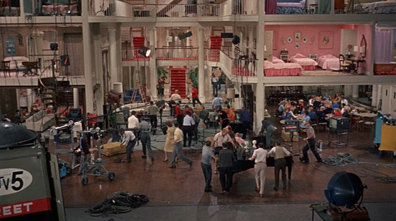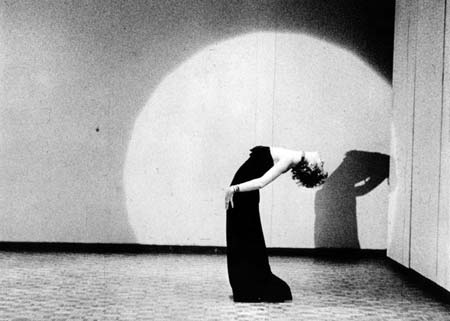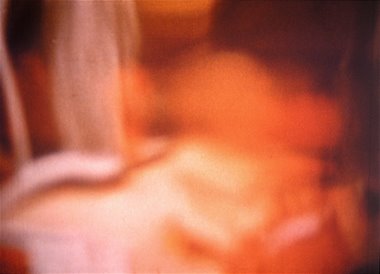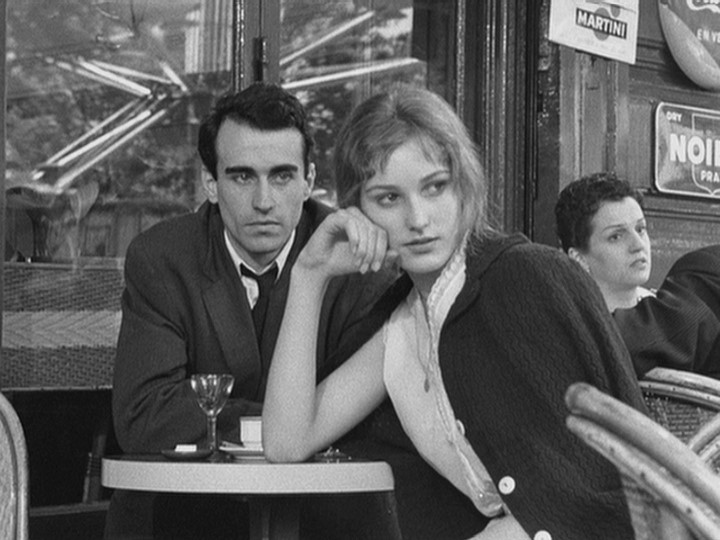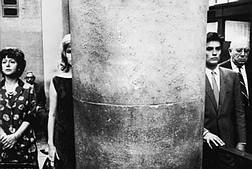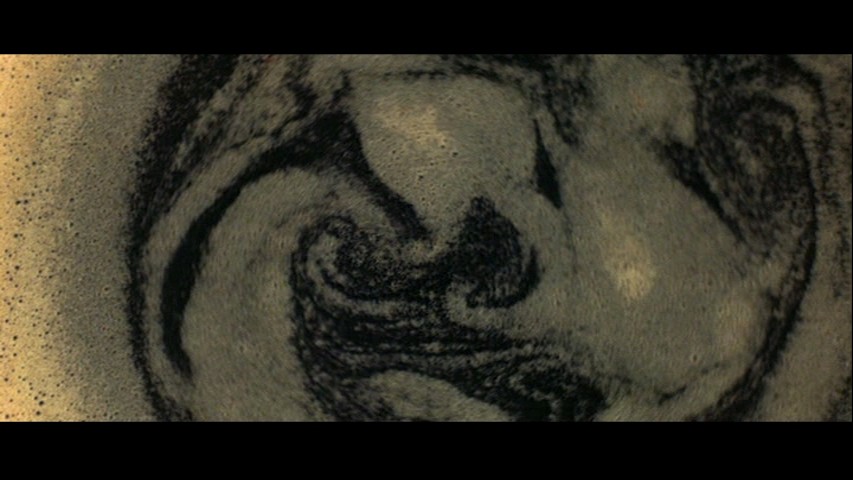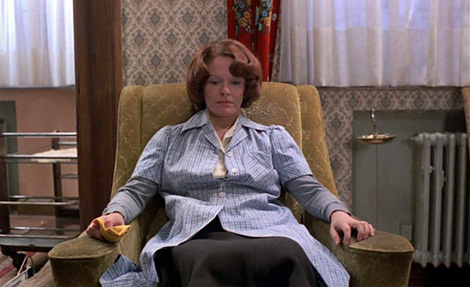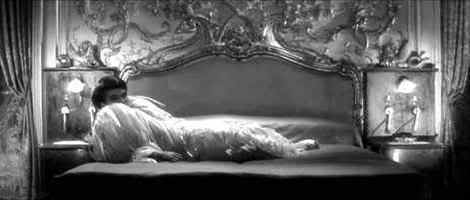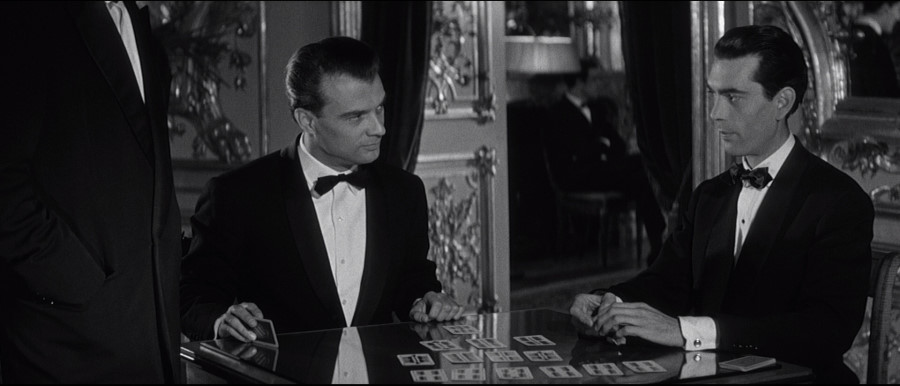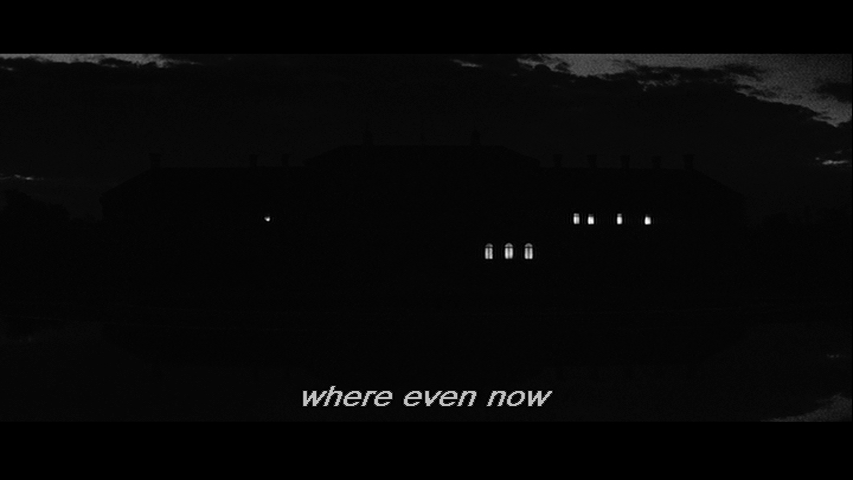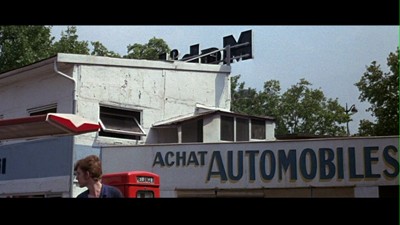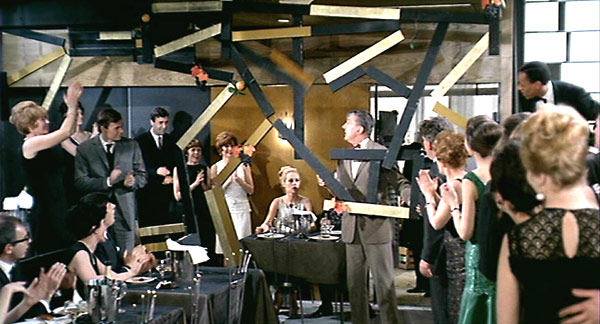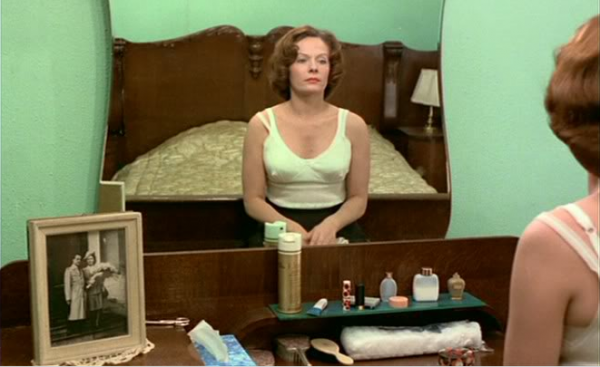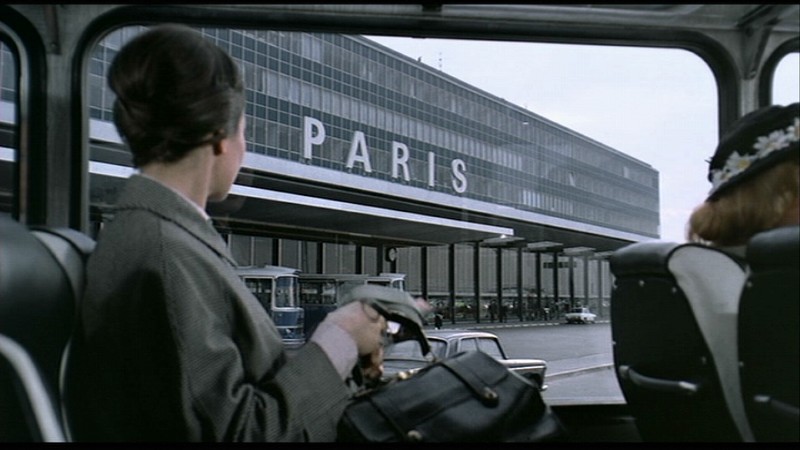From AFI Education Newsletter (January-February 1982). Because of the length of this, I’ll be running it in two installments. — J.R.
Course File:
EXPERIMENTAL FILM:
FROM UN CHIEN ANDALOU TO CHANTAL AKERMAN (Part 2)
UNIT III: German and Soviet Experimentation in the Twenties
Part of the strategy of studying German and Soviet experimentation over roughly the same period is the striking contrast between these national film movements and their relationship to popular genres as well as their different themes and subjects. On the one hand, one finds the efforts of a Fritz Lang to experiment with the thriller format, and those of F.W. Murnau (and his scriptwriter Carl Mayer) to construct an essentially non-verbal visual language. On the other hand, one finds the relatively less script-bound experiments with montage and certain documentary principles provided by the Soviet filmmakers. An interesting topic to consider speculatively is the Soviet version of Lang’s first Dr. Mabuse film, which was re-edited by Eisenstein for Russian audiences.
Screenings:
Bronenosets Potemkin (The Battleship Potemkin) (1925, 65 min.) Directed by Sergei Eisenstein — Perhaps the most famous of all experimental films, including some 1300 shots, Eisenstein’s classic is structured in five “acts.” Along with Strike, made the previous year, this is the most accessible of Eisenstein’s silent films, and might be contrasted with October (or significant portions thereof) in terms of the different principles of montage at work. (A comparison of the bridge-raising sequence in the latter with the Odessa Steps sequence in Potemkin might be useful.)
Sunrise (1927, 97 min.) Directed by F.W. Murnau — This, of course, is neither a German film nor a Soviet one, but as an experimental (and expensive) Hollywood feature of the period made almost entirely with a German crew, and highly reflective of the influence of German Expressionism, it may offer even more to a course in experimental film than such German films directed by Murnau as Nosferatu,The Last Laugh or Faust. One should note in passing that the sound version of this film is very much to be preferred to the silent one; indeed, Dr. Hugo Riesenfeld’s provocative and original blend of music and sound effects deserves close study in its own right.
Spione (Spies) (1928, 86 min.) Directed by Frilz Lang — A thriller which develops and refines the themes and structures of Lang’s first Dr. Mabuse film while anticipating those of M, Spione can probably be approached most profitably through its editing — which, along with early uses of sound, is a central concern of this Unit. The fact that this was a highly commercial UFA production makes its inclusion in a course on experimental film somewhat polemical and debatable; that is to say, the teacher shouldn’t take its experimental nature for granted. But the fact that Eisenstein edited the Soviet version of Dr Mabuse der Spieler might stimulate an interesting discussion on the differences between the functions of editing in the films of both directors, and a consideration of whether the greater narrative emphasis in Lang’s case disqualifies him as an experimenter.
Enthusiasm (1931, 96 min.) Directed by Dziga Vertov — Alternately known as Symphony of the Donbas, this remarkable documentary about the efforts of the Don Basin region to fulfill certain agricultural and industrial tasks during the First Five Year Plan is ideally suited for a consideration of the experimental uses ofsound, as well as the anti-illusionism in Vertov’s work that is equally evident (albeit only in visual terms) in the silent Man with the Movie Camera, made two years earlier. One of the few early sound films that addressed sound as a subject, and not merely as a formal means of articulation, Enthusiasm is no less valuable in broaching the area comprised by the experimental documentary — an area in which Buñuel’s Land without Bread and the films of Michelangelo Antonioni, Andy Warhol, Jean-Luc Godard, Jean Rouch and Chris Marker might also be considered.
Readings:
Burch, Noël, “Fritz Lang: German Period,” in Cinema: A Critical Dictionary, Vol. 2 edited by Richard Roud, New York: The Viking Press, 1980, pp. 583-599.
Eisner, Lotte H., Murnau, Berkeley: The Uni versity of California Press, 1973.
Fischer, Lucy, ” Enthusiasm: From Kino-Eye to Radio-Eye,” Film Quarterly, Winter 1977/8, printed with.Peter Kubelka interview about restoration of film, pp. 25-36.
Marshall, Herbert, ed., The Battleship Potemkin, New York: Avon, 1978.
Michelson, Annette, “From Magician to Epistemologist,” in The Essential Cinema, edited by P. Adams Sitney, New York: Anthology Film Archives and New York University Press, 1975, pp. 96-111 .
Rosenbaum, Jonathan, review of Spione, Monthly Film Bulletin, May 1976, p. 112.
Sitney, P. Adams, “Dovzhenko’s lntellectual Montage,” in The Essential Cinema, op. cit., pp. 88-94. See also Sitney’s article on Dovzhenko in Cinema: A Critical Dictionary, op. cit., Vol. 1, pp. 279-290.
UNIT IV: North American Experimental Filmmaking, 1941 -1972
This Unit runs the gamut from the innovative Hollywood studio work of Orson Welles and Jerry Lewis to the underground experiments of Stan Brakhage, Michael Snow and Yvonne Rainer. In regional terms, the ground covered in the latter category extends from the Colorado of Brakhage to the New York of Rainer to the Canada of Snow. The relations of Snow and Rainer to popular cinema, explored in part in the readings below, are both subtle and complex; like Welles’ background in theater and radio, and Rainer’s background in dance and performance, these cultural crossovers are worth exploring in some depth.
Screenings:
Citizen Kane (1941, 119 min.) Directed by Orson Welles — This well-known first feature by Welles can of course be approached in numerous ways (the André Bazin book cited above offers merely one example), although, like The Passion of Joan of Arc in Unit II, one may wish to treat it as a culmination and synthesis of many different strains in experimental filmmaking that preceded it.
The Ladies Man (1961,106 min.) Directed by Jerry Lewis — While the teacher might well regard this film, Lewis’s second feature as a director, as an unlikely or debatable entry for a course in experimental filmmaking, classroom experience has revealed it to b an excellent vehicle for discussion of many pertinent topics (such as discontinuous narrative, formal gags and self-referential devices) — as is Lewis’s first feature The Bellboy (1960) and Frank Tashlin’s Will Success Spoil Rock Hunter?, both of which can be regarded as excellent substitutes. Many of Godard’s boldest procedures of visual analysis and parody are anticipated in all three of these films, whose eclectic and highly original structures permit a surprising amount of conceptual invention and formal experimentation.
Wavelength (1967, 45 min.) Directed by Michael Snow — A film that has often been described somewhat incorrectly as a single continuous zoom shot, Wavelength in fact charts a journey across a loft through changes of light, color, texture, sound and visual field that becomes a grand metaphor for perceptual and philosophical investigation, not to mention the forward thrust of narrative itself. Four separate human events, including a death and a subsequent discovery of that death, intersect with this inexorable trajectory towards a photograph of sea waves on the opposite wall. As Snow himself describes the process, “The space starts at the camera’s (spectator’s) eye, is in the air, then is on the screen, then is within the screen (the mind).”
Scenes from Under Childhood (1974, 144 min.) Directed by Stan Brakhage — As much an instance of personal, autobiographical cinema as Blood of a Poet or 2 or 3 Things I Know About Her, in spite of its relative freedom from the forms and constraints of narrative, Brakhage’s ambitious, large-scale “drama” about himself and his family is split into four distinct sections, each running between half an hour and 45 minutes. The only entirely silent film in this Unit, it utilizes complex color variations in a manner that was inspired, according to Brakhage, by the music of Olivier Messaien.
Lives of Performers (1972, 95 min.) Directed by Yvonne Rainer — Opening with a quotation from Leo Bersani about the use of cliché as a principle of intelligibility, Rainer’s first feature is intimately related to some of her previous dance and performance work. It enlists her own performers and herself in a web of imaginary relationships with one another (though drawn from actual autobiographical material), placed in a fictive relationship to their own performances (viewed retrospectively, in stills). The result is a sort of distanced, deadpan comedy of psychological ambiguity that echoes such New Wave filmmakers as Godard and Rivette in many of its preoccupations.
Readings:
Bazin, André, Orson Welles: A Critical View, New York: Harper Colophon Books, 1978.
Cohen, Phoebe, “Scenes from Under Childhood,” Artforum, January 1973, pp. 51-55.
Coursodon, Jean-Pierre, “Jerry Lewis’s Films: No Laughing Matter?,” Film Comment, July-August 1975, pp. 9-15.
Lewis, Jerry, The Total Film-Maker, New York: Warner Paperback Library, 1973.
Michelson, Annette, “Toward Snow (Part l),” Artforum, June 1970, pp. 30-37.
Michelson, Annette, “Yvonne Rainer, Part Two: Lives of Performers,” Artforum, February 1974.
Rainer, Yvonne , Work 1961-73, Halifax/New York: The Press of the Nova Scotia College of Art and Design and New York University Press, 1974 (includes shooting script of Lives of Performers, pp. 213-240).
UNIT V: The New Wave and Its Antecedents, Cousins and Consequences
Returning to France in this final Unit again provides the teacher with a useful focal point in an area that also includes many non-French filmmakers, e.g. the ltalian Michelangelo Antonioni, and the Belgian Chantal Akerman. But, as with France in the 20s, the creative burst of experimentation by young filmmakers which comprised the New Wave was largely prompted by the resurgence of a self-conscious awareness of cinema as an art form. (Significantly, in this Unit as in Unit II, most of the filmmakers involved have backgrounds as critics or theorists.)
Screenings:
Pickpocket (1959, 75 min.) Directed by Robert Bresson — In a plot loosely adapted from Dostoevsky’s Crime and Punishment, a reclusive dropout gradually instructs himself in the techniques of a pickpocket and practices this profession until he is caught; only when he is in jail does he achieve a kind of salvation and the capacity to love. Bresson’s pared-away drama, as experimental for its use of sound and its elliptical framings as for its deliberate avoidance of acting and psychology, can be seen as a direct precursor of films by Godard (Vivre sa Vie).
L’Année Dernière à Marienbad (Last Year at Marienbad) (1961, 93 min.) Directed by Alain Resnais and scripted by Alain Robbe-Grillet — This controversial, rigorously constructed narative enigma can be seen, in both its mystifications and its equally deliberate demystifications, as a critique of the processes of narrative illusion and their attending seductions. Creating an ambiguous continuum of sequences set in the past, present, future and conditional tenses — stations more of the mind than of concrete time or space — this haunting fable excitingly manipulates and exposes the machinery of narrative enchantment through the same panoply of techniques.
L’Eclisse (Eclipse) (1961, 125 min.) Directed by Michelangelo Antonioni — A remarkable love story, set in contemporary Rome, between a translator and stock broker, this film is worth examining in relation to several active polarities: documentary and closely choreographed mise en scène (which are intricately interwoven in the stock exchange sequences), human and inanimate forms (particularly in the opening and closing sequences), extended takes (as in the beginning) and montage (as in the closing 7-minute sequence of 58 shots in which neither of the central characters appears).
2 ou 3 Choses que je sais d’elle (2 or 3 Things I Know About Her(1966, 95 min.) Directed by Jean-Luc Godard — This is probably the most ambitious of Godard’s early efforts in articulating the possibilities of a film essay through a complex social critique of prostitution and city planning (and the implicit relationships between the two) in the Paris region. Closer to documentary in certain respects than Godard’s other films of this period — with the fictional trajectory of a suburban housewife, played by Marina Vlady, largely used as a semiperfunctory structuring device, and Godard himself whispering a poetic offscreen commentary — it provides a most interesting contrast to Enthusiasm (in Unit III), on several levels.
Playtime (1967, 120 min.) Directed by Jacques Tati — By depicting the modern city as a complex social organism menaced by architecture, Tati’s comic masterpiece reformulates many of the same issues of 2 or 3 Things I Know About Her, yet in a completely different manner that is relatively non-verbal and physical. At the same time, it is surely no less experimental and innovative — for its gigantic city set (comparable to that in Sunrise), its extremely complex perceptual play with shifting multiple focal points (every scene is in long shot) and a mise en scène that in certain sequences becomes as densely populated as a Brueghel painting, and its highly original deployments of color and sound.
Céline et Julie Vont en Bateau (Celine and Julie Go Boating) (1974, 195 min.) Directed by Jacques Rivette — Here again (and in the following film as well), we encounter the potential difficulty of a work with an unusually long running time within a classroom setting (or outside it, for that matter). However, the special appeal that this madcap comedy can have for students — above all, its capacity to make the issues of narrative and illusionism both accessible and enjoyable, in a spirited fantasy double-plot utilizing two pairs of highly skilled actresses – seems to make its virtues outweigh its practical difficulties. As a further argument for the long experimental film, one might add that the longer-than-usual film fosters the (correct) impression that it is exceptional, hence deserving of more than conventional expectations and responses, while conventional running times tend to encourage the perpetuation of commercial filmgoing habits. And ideally, any serious course in experimental film should consider and perhaps countenance certain experiments in filmgoing and film attendance — even if this challenges or alters conventional scheduling and programming reflexes.
Jeanne Dielman, 23 Quai de Commerce, 1080 Bruxelles (Jeanne Dielman) (1975, 195 min.) Directed by Chantal Akerman -– This beautifully composed yet disturbing epic devoted to compulsive housework is at once a powerful political statement — deceptively simple at first look, in fact complexly conceived and experienced — and a summary of certain painterly and structural concerns in experimental filmmaking (as exemplified in the work of Warhol and Snow) confronting the forms, conventions and concerns of mainstream narrative filmmaking. Akerman’s frontal medium-shot mise en scène, the camerawork of Babette Mangolte (who also shot Liyes of Performers, in Unit IV) and the title performance of Delphine Seyrig (the heroine in Last Year at Marienbad) are all stunning achievements worthy of detailed analysis.
Readlngs:
Fischer, Lucy, “‘Beyond Freedom and Dignity’: An Analysis of Jacques Tali’s Playtime,” Sight and Sound, Autumn 1976, pp.234-239.
Guzzetti, Allred, Two or Three Things I Know About Her: Analysis of a Film by Godard, Cambridge, Massachusetts: Harvard University Press, 1981 .
Houston, Penelope, review of Last Year at Marienbad, Sight and Sound, Winter 1961/2, pp.26-28. t
Nowell-Smith, Geoffrey, “Shape and Black Point” (on Antonioni), in Movies and Methods, edited by Bill Nichols, Berkeley: University of California Press, 1976, pp. 354-363.
Patterson, Patricia and Manny Farber, “Kitchen without Kitsch” (on Jeanne Dielman), Film Comment, November-Decembet 1977, pp. 47-50.
Robbe-Grillet, Alain, Last Year at Marienbad, New York: Grove Press, ‘1962.
Rosenbaum, Jonathan, “Edinburgh Encounters” (on Jeanne Dielman) Sight and Sound, Winter 1975/6, pp. 18-23.
Rosenbaum, Jonathan, “Work and Play in the House of Fiction” (on Rivette) , Sight and Sound, Autumn 1974, published with interview with Rivette, pp. 190-198.
Sontag, Susan, “Spiritual Style in the Films of Robert Bresson,” in Against lnterpretation, New York: Delta, 1966, pp. 177-195.







